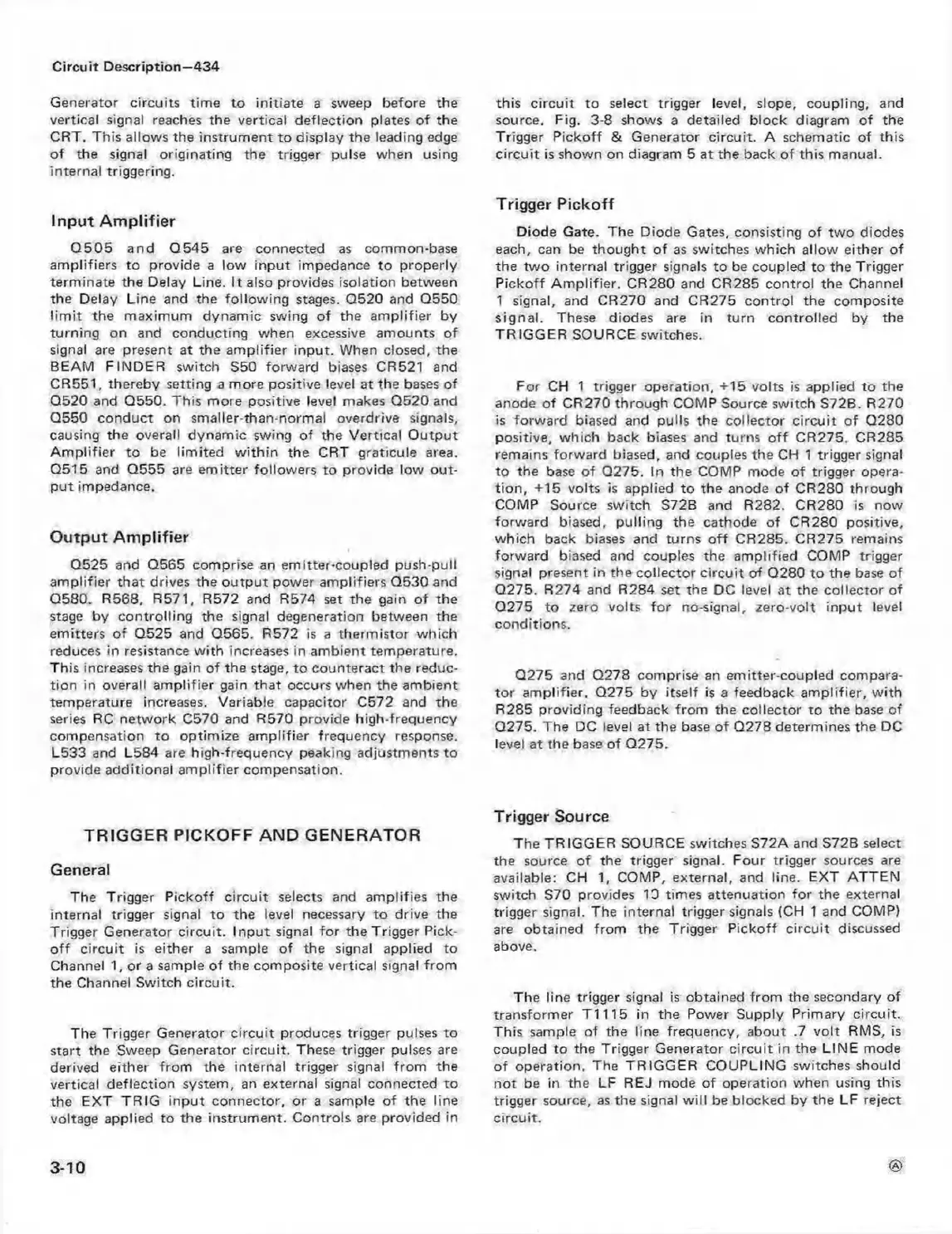Circuit Description—434
Generator circuits time to initiate a sweep before the
vertical signal reaches the vertical deflection plates of the
CRT. This allows the instrument to display the leading edge
of the signal originating the trigger pulse when using
internal triggering.
Input A m plifier
Q 505 and Q545 are connected as common-base
amplifiers to provide a low input impedance to properly
terminate the Delay Line. It also provides isolation between
the Delay Line and the following stages. Q520 and Q550
lim it the maximum dynamic swing of the am plifier by
turning on and conducting when excessive amounts of
signal are present at the am plifier input. When closed, the
BEAM FINDER switch S50 forward biases CR521 and
CR551, thereby setting a more positive level at the bases of
Q520 and Q550. This more positive level makes Q520 and
Q550 conduct on smaller-than-normal overdrive signals,
causing the overall dynamic swing of the Vertical O utput
A m plifier to be lim ited w ithin the CRT graticule area.
Q515 and Q555 are em itter followers to provide low o u t
put impedance.
Output A m plifier
Q525 and Q565 comprise an emitter-coupled push-pull
am plifier that drives the output power amplifiers Q530 and
Q580. R568, R571, R572 and R574 set the gain of the
stage by controlling the signal degeneration between the
emitters of Q525 and Q565. R572 is a thermistor which
reduces in resistance with increases in ambient temperature.
This increases the gain of the stage, to counteract the reduc
tion in overall amplifier gain that occurs when the ambient
temperature increases. Variable capacitor C572 and the
series RC network C570 and R570 provide high-frequency
compensation to optimize amplifier frequency response.
L533 and L584 are high-frequency peaking adjustments to
provide additional amplifier compensation.
TRIGGER PICKOFF AND GENERATOR
General
The Trigger Pickoff circuit selects and amplifies the
internal trigger signal to the level necessary to drive the
Trigger Generator circuit. Input signal for the Trigger Pick
o ff circuit is either a sample of the signal applied to
Channel 1, or a sample of the composite vertical signal from
the Channel Switch circuit.
The Trigger Generator circuit produces trigger pulses to
start the Sweep Generator circuit. These trigger pulses are
derived either from the internal trigger signal from the
vertical deflection system, an external signal connected to
the EXT TRIG input connector, or a sample of the line
voltage applied to the instrument. Controls are provided in
this circuit to select trigger level, slope, coupling, and
source. Fig. 3-8 shows a detailed block diagram of the
Trigger Pickoff & Generator circuit. A schematic of this
circuit is shown on diagram 5 at the back of this manual.
Trigger Pickoff
Diode Gate. The Diode Gates, consisting of tw o diodes
each, can be thought of as switches which allow either of
the tw o internal trigger signals to be coupled to the Trigger
Pickoff A m plifier. CR280 and CR285 control the Channel
1 signal, and CR270 and CR275 control the composite
signal. These diodes are in turn controlled by the
TRIGGER SOURCE switches.
For CH 1 trigger operation, +15 volts is applied to the
anode of CR270 through COMP Source switch S72B. R270
is forward biased and pulls the collector circuit of Q280
positive, which back biases and turns o ff CR275. CR285
remains forward biased, and couples the CH 1 trigger signal
to the base of Q275. In the COMP mode of trigger opera
tion, + 15 volts is applied to the anode of CR280 through
COMP Source switch S72B and R282. CR280 is now
forward biased, pulling the cathode of CR280 positive,
which back biases and turns o ff CR285. CR275 remains
forward biased and couples the am plified COMP trigger
signal present in the collector circuit of Q280 to the base of
Q275. R274 and R284 set the DC level at the collector of
Q275 to zero volts fo r no-signal, zero-volt input level
conditions.
Q275 and Q278 comprise an emitter-coupled compara
tor amplifier. Q275 by itself is a feedback am plifier, w ith
R285 providing feedback from the collector to the base of
Q275. The DC level at the base of Q278 determines the DC
level at the base of Q275.
Trigger Source
The TRIGGER SOURCE switches S72A and S72B select
the source of the trigger signal. Four trigger sources are
available: CH 1, COMP, external, and line. EXT ATTEN
switch S70 provides 13 times attenuation for the external
trigger signal. The internal trigger signals (CH 1 and COMP)
are obtained from the Trigger Pickoff circuit discussed
above.
The line trigger signal is obtained from the secondary of
transformer T il 15 in the Power Supply Primary circuit.
This sample of the line frequency, about .7 volt RMS, is
coupled to the Trigger Generator circuit in the LINE mode
of operation, The TRIGGER COUPLING switches should
not be in the LF REJ mode of operation when using this
trigger source, as the signal w ill be blocked by the LF reject
circuit.
3-10

